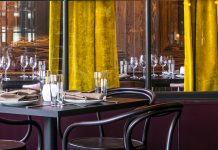
Courtesy of Heidi Geldhauser
Located just a few steps south of Emory University, the strip of shops known as Emory Village has developed a reputation for being a notoriously difficult area for restaurants. Four have shuttered in the last four years, among them Ink & Elm and Everybody’s Pizza, which had been a student-favorite for nearly four decades.
The village’s lagging reputation is in stark contrast to the newly-built Emory Point, a mixed-use development featuring two-dozen restaurants and businesses just on the other side of campus. The development recently completed its second phase of construction and now boasts more than 80,000 square-feet of retail space.
And yet, when Fred Castellucci decided to relocate Double Zero Napoletana from Sandy Springs, he shied away from Emory Point in favor of the village. “When I look at real estate for a restaurant, there’s got to be some element of character baked into it already. The village has so much more character than Emory Point, and even though it’s just on the other side of the Emory area, the village seems more intown. It’s closer to Ponce and the Highlands. There’s almost more of a city feel to it.”
Indeed, Castellucci believes that he will succeed where others have not. “We’re going to give that area the energy that it’s lacked,” he says. Below, Castellucci elaborates.
Will the Emory Village location be a copy-cat of what’s in Sandy Springs right now? Or do you have ideas about adapting the menu to fit the needs and budgets of college students?
My idea behind it, originally, was to give us the opportunity to rethink everything. The interior, the graphic design, the logo, the branding, all of that is changing to give it a whole new look. The menu design is changing, too. We’re going towards more of a small plates and small pastas, pizzas and large format proteins. Not that we’re not proud of what we’re currently doing at Double Zero, but a new neighborhood really gives us the opportunity to do something different.
What was involved in choosing a new location?
It was this process that came about organically over the past couple years. We knew the location in Sandy Springs was on the market and our first five-year term was coming up. We wanted to find a space that was a little bit smaller. The location in Sandy Springs is really big, and that gives us some operational challenges. I’ve learned a lot over the years about what size restaurants are ideal for the quality of the operation we want to do. There’s a certain number of seats we can execute for the quality of the product we want to put out, and when you go over that number it becomes really hard to execute at a high level. You end up having to take shortcuts, or change the operation. I also wanted to be closer to our successful intown restaurants, Cooks and Soldiers and Iberian Pig. It makes it easier to move around staff and operate the company. I live in Morningside, so I wanted to be able pop into the restaurant at any given point in time.
The Final Piece was really Emory Village. I really like areas that have walkability and density and some interesting intellectual pursuits going on around it. That particular location has been lacking something for a long time. I feel like people in town really like that area and want to go there and want to see cool things there, but there really hasn’t been anything there to get people excited.
So you talk about liking the vibe of Emory Village, but it’s a tough place to thrive. There are no high-end restaurants there, and Ink & Elm last closed in that space. Why do you think it didn’t work for them and how are you going to avoid the same pitfalls?
There’s a certain level of dining that’s not going to work in Emory Village, but let’s be honest how many true fine dining restaurants succeed in Atlanta anyway? You had a first time restaurateur trying to do, not necessarily a tasting menu restaurant, but pretty close. That was one of their big challenges. I think also they had like three restaurants they tried to combine into one space, with the tavern on one side, the fine dining restaurant on the other, and a martini bar in the middle. Conceptually it just didn’t come together.
I do think that there’s enough of a demand there for a nicer dining experience. I think too many people look at it and say, ‘Oh it’s a college town so we’re going to do something really cheap,’ but it still is in Atlanta.
There’s a few other pizza restaurants on the same block (Slice & Pint, Romeo’s, Domino’s). How are you going to distinguish yourself from them?
Double Zero always has been about a lot more than pizza and in the new location it’s going to be a small percentage of the menu. We’ll have maybe four or five pizzas, but the rest of the menu will be much more diverse.













